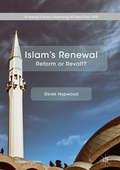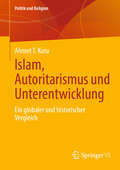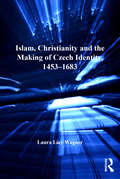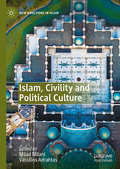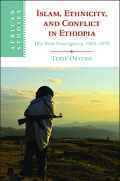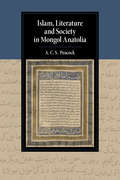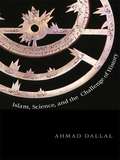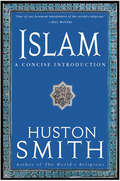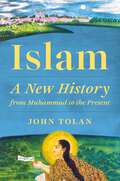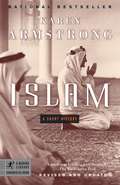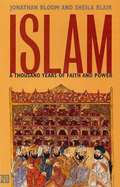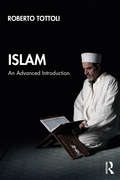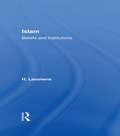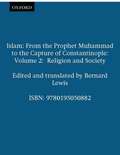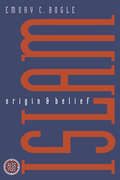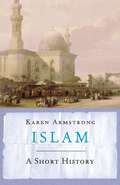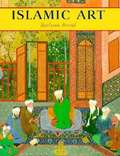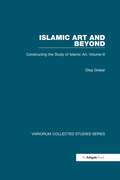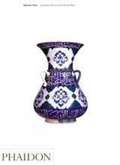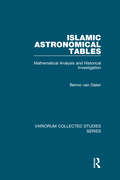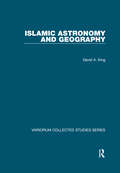- Table View
- List View
Islam's Renewal: Reform Or Revolt? (St Antony's)
by Derek HopwoodThe book considers some of the solutions proposed by Muslim activists and thinkers in their attempts to renew (tajdid) their ways of life and thought in accord with the demands of the age in which they lived. The two ways of reacting are studied – the movements led by men of action and inspiration, and the thoughts of quietist scholars who laid greater emphasis on calm continuity. These two streams have often collided and particularly so in the contemporary age of greater violence. Other related problems are also considered: how a non-Muslim should regard the religion of the ‘other’; the ways modernization have been dealt with; and the two root causes of Muslim ‘rage’ today – the invasions of the West and the failure to reach an equitable solution to the problem of Palestine. Building on the author’s sixty-year experience researching the history of Islam, the book will appeal to students and scholars across the fields of Islamic studies, religious history and Middle Eastern politics.
Islam, Autoritarismus und Unterentwicklung: Ein globaler und historischer Vergleich (Politik und Religion)
by Ahmet T. KuruWarum weisen Länder mit muslimischer Bevölkerungsmehrheit im Vergleich zum Weltdurchschnitt ein niedriges Maß an Demokratie und sozioökonomischer Entwicklung auf? Dieses Buch kritisiert Erklärungen, die den Islam als Ursache dieser Ungleichheit anführen, da die Muslime zwischen dem 9. und 12. Jahrhundert philosophisch und sozioökonomisch weiter fortgeschritten waren als die Westeuropäer. Auch der westliche Kolonialismus war nicht die Ursache: Die Muslime litten bereits unter politischen und sozioökonomischen Problemen, als die Kolonisierung begann. Dieses Buch argumentiert, dass die Muslime in ihrer frühen Geschichte, als in Europa religiöse Orthodoxie und Militärherrschaft vorherrschten, einflussreiche Denker und Kaufleute hatten. Im 11. Jahrhundert entstand jedoch ein Bündnis zwischen orthodoxen islamischen Gelehrten (den Ulema) und Militärstaaten. Dieses Bündnis erstickte allmählich die intellektuelle und wirtschaftliche Kreativität, indem es die intellektuellen und bürgerlichen Klassen in der muslimischen Welt marginalisierte. Dieses Bündnis behindert auch heute noch Kreativität und Wettbewerb in muslimischen Ländern. Die Rohfassung der deutschen Übersetzung hat ein maschinelles Übersetzungsprogramm mit Hilfe künstlicher Intelligenz angefertigt. Eine anschließende menschliche Überarbeitung erfolgte vor allem in inhaltlicher Hinsicht, so dass sich das Buch stilistisch anders lesen wird als eine herkömmliche Übersetzung.
Islam, Christianity and the Making of Czech Identity, 1453-1683 (Transculturalisms, 1400-1700)
by Laura Lisy-WagnerUnlike many narratives about the Czech lands, which place them on the periphery of their own history, this study considers Czechs as central characters, looking both east and west to find their place in the early modern world. Islam, Christianity and the Making of Czech Identity, 1453-1683 works through the descriptive and ethnographic texts produced by Czech speakers about Islam and the Ottoman Empire to show how they used this discourse to create Czech identities. Rather than simply constructing identity in opposition to the Islamic Other, Laura Lisy-Wagner shows how these authors played the Holy Roman and Ottoman Empires off each other, creating an autonomous space for themselves in between. Lisy-Wagner introduces sources that are new to English-language historiography and uses them in a way that is new to Czech historiography as well. The chapters are organized based on different categories of agents-travelers, ethnographers, religious leaders, artists, and political revolutionaries-whose voices cast ideas of Europe and Czech identity in the early modern period in a new and different light.
Islam, Civility and Political Culture (New Directions in Islam)
by Milad Milani Vassilios AdrahtasThis book provides a comprehensive and interdisciplinary exploration of civility and political culture in the Muslim world.The contributions consider the changing interface between religion and politics throughout Islamic history, and into the present. Extending beyond saturated approaches of ‘political’ and/or ‘militant’ Islam, this collection captures the complex sociopolitical character of Islam, and identifies tensions between the political-secular and the sacred-religious in contemporary Muslim life. The alternative conceptual framework to traditional analyses of secularisation and civility presented across this volume will be of interest to students and scholars across Islamic studies, religious studies, sociology and political science, civilisation studies, and cultural studies.
Islam, Ethnicity, and Conflict in Ethiopia: The Bale Insurgency, 1963-1970 (African Studies #151)
by Terje ØstebøFocusing on the role of religion and ethnicity in times of conflict, Terje Østebø investigates the Muslim-dominated insurgency against the Ethiopian state in the 1960s, shedding new light on this understudied case in order to contribute to a deeper understanding of religion, inter-religious relations, ethnicity, and ethno-nationalism in the Horn of Africa. Islam, Ethnicity and Conflict in Ethiopia develops new theoretical perspectives on the interrelations between ethnic and religious identities, considering ethnic and religious groups as mutually exclusive categories by applying the term peoplehood as an analytical tool, one that allows for more flexible perspectives. Exploring the interplay of imagination and lived, affective reality, and inspired by the 'materiality turn' in cultural- and religious studies, Østebø argues for an integrated approach which recognizes and explores embodiment and emplacement as intrinsic to formations of ethnic and religious identities.
Islam, Literature and Society in Mongol Anatolia (Cambridge Studies in Islamic Civilization)
by Andrew A.C.S. PeacockFrom a Christian, Greek- and Armenian-speaking land to a predominantly Muslim and Turkish speaking one, the Islamisation of medieval Anatolia would lay the groundwork for the emergence of the Ottoman Empire as a world power and ultimately the modern Republic of Turkey. Bringing together previously unpublished sources in Arabic, Persian and Turkish, Peacock offers a new understanding of the crucial but neglected period in Anatolian history, that of Mongol domination, between c. 1240 and 1380. This represents a decisive phase in the process of Islamisation, with the popularisation of Sufism and the development of new forms of literature to spread Islam. This book integrates the study of Anatolia with that of the broader Islamic world, shedding new light on this crucial turning point in the history of the Middle East.
Islam, Migrancy, and Hospitality in Europe (Literatures and Cultures of the Islamic World)
by Meyda YeğenoğluThis book cuts across important debates in cultural studies, literary criticism, politics, sociology, and anthropology. Meyda Yegenoglu brings together different theoretical strands in the debates regarding immigration, from Jacques Lacan's psychoanalytic understanding of the subject formation, to Zygmunt Bauman's notion of the stranger.
Islam, Nationalism and Communism in a Traditional Society: The Case of Sudan
by Gabriel WarburgFirst Published in 1978. Routledge is an imprint of Taylor & Francis, an informa company.
Islam, Science, and the Challenge of History
by Ahmad DallalIn this wide-ranging and masterful work, Ahmad Dallal examines the significance of scientific knowledge and situates the culture of science in relation to other cultural forces in Muslim societies. He traces the ways in which the realms of scientific knowledge and religious authority were delineated historically. The realization of a discrepancy between tradition and science often led to demolition and rebuilding and, most important, to questioning whether scientific knowledge should take precedence over religious authority in a matter where their realms clearly overlap. Dallal frames his inquiry around three concerns: What cultural forces provided the conditions for debate over the primacy of religion or science? How did these debates emerge? And how were they sustained? His primary objectives are to study science in Muslim societies within its larger cultural context and to trace the epistemological distinctions between science and philosophy, on the one hand, and science and religion, on the other. He looks at religious and scientific texts and situates them in the contexts of religion, philosophy, and science. Finally, Dallal describes the relationship negotiated in the classical (medieval) period between the religious, scientific, and philosophical systems of knowledge that is central to the Islamic scientific tradition and shows how this relationship has changed radically in modern times.
Islam: A Concise Introduction
by Huston SmithOriginally titled The Religions of Man, this completely revised and updated edition of Smith's masterpiece, now with an engaging new foreword, explores the essential elements and teachings of the world's predominant faiths, including: Hinduism, Buddhism, Confucianism, Taoism, Islam, Judaism, Christianity, and the native traditions of the Americas, Australia, Africa, and Oceania. Emphasizing the inner -- rather than institutional -- dimensions of these religions, Smith devotes special attention to Zen and Tibetan Buddhism, Sufism, and the teachings of Jesus. He convincingly conveys the unique appeal and gifts of each of the traditions and reveals their hold on the human heart and imagination.
Islam: A New History from Muhammad to the Present
by John TolanA concise new narrative history of Islam that draws on the transformative insights of recent research to emphasize the diversity and dynamism of the traditionToday&’s Muslim world is in upheaval: legalists and mystics engage in intense debates, radical groups invoke Sharia, Muslim immigrants in the West face prejudice and discrimination, and Muslim feminists advocate new interpretations of the Koran. At the same time, Islam is mischaracterized as unitary and unchanging by people ranging from right-wing Western politicians claiming that Islam is incompatible with democracy to conservative Muslims dreaming of returning to the golden age of the prophet. Against this contentious backdrop, this book provides an essential and timely new history of the religion in all its astonishing richness and diversity as it has been practiced by Muslims around the world, from seventh-century Mecca to today.Most popular histories of Islam continue to repeat conventional pietistic accounts. In contrast, John Tolan draws on decades of new historical research that has transformed knowledge of the origins and development of the Muslim faith. He shows how the youngest of the three great monotheisms arose in close contact with Jewish, Christian, and other religious traditions in a mixture of cultures, including Arab, Greek, Persian, and Turkish; how Islam spread across an enormous territory encompassing hundreds of languages and cultures; how Muslims have forged widely different beliefs and practices over fourteen centuries; and how Islamic history provides crucial context for understanding contemporary debates in the Muslim world.At a time when much talk about Islam is filled with misunderstanding, stereotypes, and bias, this book provides a fresh and lucid portrait of the continuous and ongoing transformations of a religion of tremendous variety and complexity.
Islam: A Short History (Modern Library Chronicles #2)
by Karen ArmstrongIn the public mind, Islam is a religion of extremes: it is the worlds fastest growing faith; more than three-quarters of the worlds refugees are Islamic; it has produced government by authoritarian monarchies in Saudi Arabia and ultra-republicans in Iran. Whether we are reading about civil war in Algeria or Afghanistan, the struggle for the soul of Turkey, or political turmoil in Pakistan or Malaysia, the Islamic context permeates all these situations. Karen Armstrongs elegant and concise book traces how Islam grew from the other religions of the book, Judaism and Christianity; introduces us to the character of Muhammed; and demonstrates that for much of its history, the religion has been a force for enlightenment that promoted liberties for women and allowed the arts and sciences to flourish. Islam shows how this progressive legacy is today often set aside as the faith struggles to come to terms with the economic and political weakness of most of its believers and with the forces of modernity itself.
Islam: A Thousand Years of Faith and Power
by Jonathan Bloom Sheila S. BlairIn its first thousand years -- from the revelations to Muhammad in the seventh century to the great Islamic empires of the sixteenth -- Islamic civilization flourished. While Europeans suffered through the Dark Ages, Muslims in such cities as Jerusalem, Damascus, Alexandria, Fez, Tunis, Cairo, and Baghdad made remarkable advances in philosophy, science, medicine, literature, and art. This engrossing and accessible book explores the first millennium of Islamic culture, shattering stereotypes and enlightening readers about the events and achievements that have shaped contemporary Islamic civilization. Jonathan Bloom and Sheila Blair examine the rise of Islam, the life of Muhammad, and the Islamic principles of faith. They describe the golden age of the Abbasids, the Mongol invasions, and the great Ottoman, Safavid, and Mughal empires that emerged in their wake. Their narrative, complemented by excerpts of the Koran, poetry, biographies, inscriptions, travel guides, and even a thirteenth-century recipe, concludes with a brief epilogue that takes us to the twentieth century. Colorfully illustrated, this book is a wonderful introduction to the rich history of a civilization that still radically affects the world.
Islam: An Advanced Introduction
by Roberto TottoliExploring complex relations between Muslim visions and critical stances, this textbook is a compact introduction to Islam, dealing with the origins of its forms, from early developments to contemporary issues, including religious principles, beliefs and practices. The author’s innovative method considers the various opposing theories and approaches between the Islamic tradition and scholars of Islam. Each topic is accompanied by up-to-date bibliographical references and a list of titles for further study, while an exhaustive glossary includes the elementary notions to allow in-depth study. Part I outlines the two founding aspects, the Qur’an and Prophet Muhammad, highlighting essential concepts, according to Islamic religious discourse and related critical issues. In Part II the emergence of the religious themes that have characterised the formation of Islam are explored in terms of historical developments. Part III, on contemporary Islam, examines the growth of Islam between the end of the Middle Ages and the beginning of the modern age. Advanced readers, already familiar with the elementary notions of Islam and religious studies will benefit from Islam that explores the development of religious discourse in a historical perspective. This unique textbook is a key resource for post-graduate researchers and academics interested in Islam, religion and the Middle East.
Islam: Beliefs and Institutions
by H. LammensFirst Published in 1968. Routledge is an imprint of Taylor & Francis, an informa company.
Islam: From The Prophet Muhammad To The Capture Of Constantinople
by Bernard LewisThis second volume examines the religion and structure of Islamic society. Bernard Lewis draws on a broad range of Islamic literature, including books on religious sects, politics and economics, philosophy and science, travel, biography and literary works, and even bureaucratic records from such disparate sources as the postal service and the judiciary. Comprehensive and cogently translated, these documents bring into sharp focus aspects of a world long neglected by Western historians.
Islam: Origin and Belief
by Emory C. BogleA concise overview of the origins, basic beliefs, and common practices of Islam, with a particular emphasis on Shi'i Islam.
Islam: The 4,000-year Quest Of Judaism, Christianity And Islam (Modern Library Chronicles Ser. #2)
by Karen ArmstrongOne of the world's foremost commentators on religious affairs on the history (and destiny) of the world's most misunderstood religion.In the public mind, Islam is a religion of extremes: it is the world's fastest growing faith; more than three-quarters of the world's refugees are Islamic; it has produced government by authoritarian monarchies in Saudi Arabia and ultra-republicans in Iran. Whether we are reading about civil war in Algeria or Afghanistan, the struggle for the soul of Turkey, or political turmoil in Pakistan or Malaysia, the Islamic context permeates all these situations.Karen Armstrong's elegant and concise book traces how Islam grew from the other religions of the book, Judaism and Christianity; introduces us to the character of Muhammed; and demonstrates that for much of its history, the religion has been a force for enlightenment that promoted liberties for women and allowed the arts and sciences to flourish.ISLAM shows how this progressive legacy is today often set aside as the faith struggles to come to terms with the economic and political weakness of most of its believers and with the forces of modernity itself.
Islamabad and the Politics of International Development in Pakistan
by Markus DaechselThis is a highly original account of the design and development of Pakistan's capital city; one of the most iconic and ambitious urban reconstruction projects of the twentieth century. Balancing archival research with fresh, theoretical insights, Markus Daechsel surveys the successes and failures of Greek urbanist Constantinos A. Doxiadis's most ambitious endeavour, Islamabad, analysing how the project not only changed the international order, but the way in which the Pakistani state operated in the 1950s and 1960s. In dissecting Doxiadis's fraught encounter with Pakistani policy makers, bureaucrats and ordinary citizens, the book offers an unprecedented account of Islamabad's place in post-war international development. Daechsel provides new insights into this period and explores the history of development as a charged, transnational venture between foreign consultants and donors on the one side and the postcolonial nation state on the other.
Islamic Art
by Barbara BrendFrom the Alhambra to the Taj Mahal, from the Dome of the Rock to the ever evolving art of calligraphy, Barbara Brend traces the development of classic Islamic art from the seventh through the twentieth century. Brend narrates this history region by region, illustrating her discussion with superb examples drawn from all areas in which Muslim artists and craftsmen have excelled--mosque and palace architecture; the art of the book (calligraphy, painting, and bindings); and the decorative arts, including metalwork, carvings, mosaics, pottery, textiles, and carpets. Throughout, the author elucidates forms, aesthetic principles, themes, and imagery. And she points to sources and influences in the different periods--for example, the prominence of jade and chinoiserie after the Mongol invasion.
Islamic Art and Architecture: 650-1250
by Richard Ettinghausen Oleg Grabar Marilyn Jenkins-Madina"This illustrated book provides an overview of Islamic art and architecture from the seventh to the thirteenth centuries, a time of the formation of a new artistic culture and its first, medieval, flowering in the vast area from the Atlantic to India. Inspired by Ettinghausen and Grabar's original text, this book has been completely rewritten and updated to take into account recent information and methodological advances. "--BOOK JACKET. Title Summary field provided by Blackwell North America, Inc. All Rights Reserved
Islamic Art and Beyond: Constructing the Study of Islamic Art, Volume III (Variorum Collected Studies)
by Oleg GrabarIslamic Art and Beyond is the third in a set of four volumes of studies on Islamic art by Oleg Grabar. Between them they bring together more than eighty articles, studies and essays, work spanning half a century by a master of the field. Each volume takes a particular section of the topic, the three other volumes being entitled: Early Islamic Art, 650-1100; Islamic Visual Culture, 1100-1800; and Jerusalem. Reflecting the many incidents of a long academic life, they illustrate one scholar's attempt at making order and sense of 1400 years of artistic growth. They deal with architecture, painting, objects, iconography, theories of art, aesthetics and ornament, and they seek to integrate our knowledge of Islamic art with Islamic culture and history as well as with the global concerns of the History of Art. In addition to the articles selected, each volume contains an introduction which describes, often in highly personal ways, the context in which Grabar's scholarship developed and the people who directed and mentored his efforts. The articles in the present volume illustrate how the author's study of Islamic art led him in two directions for a further understanding of the arts. One is how to define Islamic art and what impulses provided it with its own peculiar forms and dynamics of growth. Was it a faith or a combination of social, historical, and cultural events? And how has 'Islamic art' impacted on the contemporary arts of the Islamic world? The other issue is that of the meanings to be given to forms like domes, so characteristic of Islamic art, or to terms like symbol, signs, or aesthetic values in the arts, especially when one considers the contemporary world. The Islamic examples allow for the development of new intellectual positions for the history and criticism of the arts everywhere.
Islamic Arts
by Jonathan Bloom Sheila S. BlairA comprehensive survey that brilliantly captures the essence of Islamic culture. Islamic Arts, a comprehensive survey covering a thousand years, highlights those characteristics that connect the various arts of the Islamic lands without minimizing the differences. The book is divided into three time periods - 600-900, 900-1500 and 1500-1800 - and each section analyses architecture, the arts of the book, decorative and applied arts. Islamic Artsbrilliantly captures the essence of Islamic culture.
Islamic Astronomical Tables: Mathematical Analysis and Historical Investigation (Variorum Collected Studies #1040)
by Benno van DalenThis volume comprises nine articles on Islamic astronomy published since 1989 by Benno van Dalen. Van Dalen was the first historian of Islamic astronomy who made full use of the new possibilities of computers in the early 1990s. He implemented various statistical and numerical methods that can be used to determine the mathematical properties of medieval astronomical tables, and utilized these to obtain entirely new, until then unattainable historical results concerning the interdependence of individual tables and hence of entire astronomical works. His programmes for analysing tables, making sexagesimal calculations and converting calendar dates continue to be widely used. The five articles in the first part of this collection explain the principles of a range of statistical methods for determining unknown parameter values underlying astronomical tables and present extensive step-by-step examples for their use. The four articles in the second part provide extensive studies of materials in unpublished primary sources on Islamic astronomy that heavily depend on these methods. The volume is completed with a detailed index.
Islamic Astronomy and Geography
by David A. KingThis volume of 12 studies, mainly published during the past 15 years, begins with an overview of the Islamic astronomy covering not only sophisticated mathematical astronomy and instrumentation but also simple folk astronomy, and the ways in which astronomy was used in the service of religion. It continues with discussions of the importance of Islamic instruments and scientific manuscript illustrations. Three studies deal with the regional schools that developed in Islamic astronomy, in this case, Egypt and the Maghrib. Another focuses on a curious astrological table for calculating the length of life of any individual. The notion of the world centred on the sacred Kaaba in Mecca inspired both astronomers and proponents of folk astronomy to propose methods for finding the qibla, or sacred direction towards the Kaaba; their activities are surveyed here. The interaction between the mathematical and folk traditions in astronomy is then illustrated by an 11th-century text on the qibla in Transoxania. The last three studies deal with an account of the geodetic measurements sponsored by the Caliph al-Ma'mûn in the 9th century; a world-map in the tradition of the 11th-century polymath al-Bîrûnî, alas corrupted by careless copying; and a table of geographical coordinates from 15th-century Egypt.
